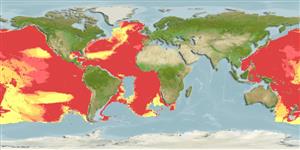Teleostei (teleosts) >
Lophiiformes (Anglerfishes) >
Oneirodidae (Dreamers)
Etymology: Dolopichthys: Greek, 'dolops' or 'dolopos' = ambusher + Greek, 'ichthys' = fish (meaning "a fish that attacks by surprise") (Ref. 86949).
More on authors: Regan & Trewavas.
Environment: milieu / climate zone / depth range / distribution range
Ecology
Marine; bathypelagic; depth range 800 - 2000 m (Ref. 86949). Deep-water
Tropical to temperate parts of all oceans.
Size / Weight / Age
Maturity: Lm ? range ? - ? cm
Max length : 11.5 cm SL (female)
Short description
Identification keys | Morphology | Morphometrics
Dorsal soft rays (total): 5 - 8; Anal soft rays: 4 - 6. Characterized by having escal morphology: escal bulb with small rounded, anteriorly to anteroventrally directed papilla on anterior midline, continuous internally with slightly larger posteriorly to posterodorsally directed papilla on dorsal midline; compressed posterior appendage sigmoidal in shape and usually twice as long as escal bulb; darkly pigmented swollen basal part of posterior appendage in specimens 84mm and larger; presence of filaments on posterior appendage, pigmented in specimens 84 mm and larger; dorsal fin rays 5-8; anal fin rays 4-6; pectoral fin rays 17-22 (Ref. 86949).
Mesopelagic (Ref. 10524).
Life cycle and mating behavior
Maturity | Reproduction | Spawning | Eggs | Fecundity | Larvae
Bertelsen, E., 1990. Oneirodidae. p. 498-507. In J.C. Quero, J.C. Hureau, C. Karrer, A. Post, and L. Saldanha (eds.) Check-list of the fishes of the eastern tropical Atlantic (CLOFETA). JNICT, Lisbon; SEI, Paris; and UNESCO, Paris. Vol. 1. (Ref. 10524)
IUCN Red List Status (Ref. 130435: Version 2024-1)
Threat to humans
Harmless
Human uses
Tools
Special reports
Download XML
Internet sources
Estimates based on models
Preferred temperature (Ref.
123201): 2.7 - 6.7, mean 4.3 °C (based on 930 cells).
Phylogenetic diversity index (Ref.
82804): PD
50 = 0.5078 [Uniqueness, from 0.5 = low to 2.0 = high].
Bayesian length-weight: a=0.01995 (0.00906 - 0.04395), b=3.01 (2.83 - 3.19), in cm total length, based on all LWR estimates for this body shape (Ref.
93245).
Trophic level (Ref.
69278): 3.8 ±0.5 se; based on size and trophs of closest relatives
Resilience (Ref.
120179): Medium, minimum population doubling time 1.4 - 4.4 years (Fecundity assumed < 1000).
Fishing Vulnerability (Ref.
59153): Low vulnerability (10 of 100).
